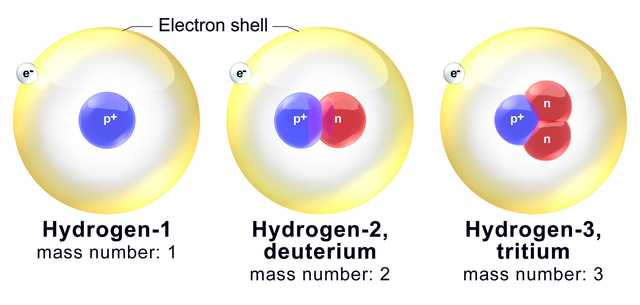The atoms of a chemical element can exist in different types that have very similar behavior, but weigh different amounts. These are called isotopes of the element. Atoms of the same element have the same number of protons, but different isotopes have different numbers of neutrons. Different isotopes of the same element have different masses because they have a different number of neutrons. Mass is the word for how much substance (or matter) something has. Things with different masses also have different weights.

Some isotopes are not stable so they change to another isotope or element by radioactive decay. These are called radioactive isotopes. Others are not radioactive. These are called stable isotopes.
Atoms of the same element have the same number of protons, which is called the atomic number. Different isotopes of an element have different numbers of neutrons. As a result, they also have different mass numbers, which is the number of protons plus the number of neutrons. An isotope is usually named by giving the element and the mass number. For example, the symbol for carbon is C and all carbon atoms have 6 protons. The most common isotope of carbon also has 6 neutrons, giving a mass number of 12, and it is written carbon-12 or 12C. The isotope of carbon that has 8 neutrons is written carbon-14 or 14C.
The word "isotope", meaning "at the same place", comes from the fact that isotopes of the same element are at the same place on the periodic table.
Chemical properties
In any neutral atom, the number of electrons is the same as the number of protons. As a result, isotopes of the same element also have the same number of electrons and the same electronic structure. The way an atom acts is decided by its electronic structure, so isotopes of the same element have almost the same chemical behavior, such as the molecules it can form. It is very difficult to separate the isotopes of an element from a mixture of different isotopes because of how similar this behavior is.
Heavier isotopes react chemically more slowly than lighter isotopes of the same element. This "mass effect" is large for protium (1H) and deuterium (2H), because deuterium has twice the mass of protium. For heavier elements, the relative atomic weight ratio between isotopes is much less, so the mass effect is usually small.
Stability
Some isotopes are not stable so they change to a different isotope or element by radioactive decay. These are called unstable isotopes, or radioactive isotopes. The average time it takes an isotope to decay is called the half-life. Other isotopes do not decay so they are not radioactive. They are called stable isotopes.
Every atom has an atomic nucleus, which is made from protons and neutrons that are held together by the nuclear force. Because protons have positive electrical charge, they repel each other. Neutrons are neutral and they stabilize the nucleus. The neutrons hold the protons slightly apart. This reduces the electrostatic repulsion between the protons, so the nuclear force can hold the protons and neutrons together. One or more neutrons are necessary for two or more protons to bind into a nucleus. As the number of protons increases, so does the number of neutrons needed to have a stable nucleus.
Some elements only have a single isotope that is stable. For example, fluorine-19 (19F) is the only stable isotope of fluorine. The other isotopes of fluorine decay rapidly so they are not found in nature. Other elements have many stable isotopes. For example, xenon has seven stable isotopes. It also has two isotopes that decay very slowly that are found in nature. The largest number of stable isotopes for any element is ten, for the element tin. Some elements do not have any stable isotopes, such as curium. These only exist on Earth because they are created in nuclear reactors, nuclear explosions, or particle accelerators.
Some unstable isotopes exist naturally on Earth because they have a very long half-life. For example, uranium-238 has a half-life of 4468 million years. The half life of radium-226 is only 1600 years, and it is found in nature because it is constantly forming from the decay of uranium-238.
Hydrogen has three common isotopes. The most common isotope of hydrogen is called protium (1H), which has one proton and no neutrons. A hydrogen atom that has a proton and a neutron (atomic mass of 2) is called deuterium (2H). Hydrogen with one proton and two neutrons (atomic mass of 3) is called tritium (3H). Protium and deuterium are stable isotopes, while tritium is a radioactive isotope.
The heaviest elements in the periodic table are all radioactive. All of the isotopes of radon, thorium, and uranium are radioactive, since they are very heavy. This is because the nuclear forces inside the nucleus of the atom cannot hold together all the protons and neutrons.
Related pages
Wikiwand in your browser!
Seamless Wikipedia browsing. On steroids.
Every time you click a link to Wikipedia, Wiktionary or Wikiquote in your browser's search results, it will show the modern Wikiwand interface.
Wikiwand extension is a five stars, simple, with minimum permission required to keep your browsing private, safe and transparent.
